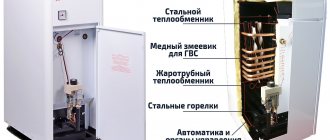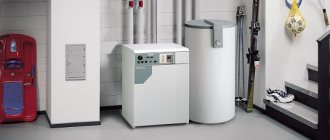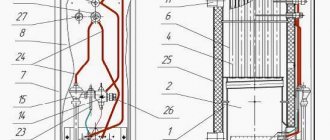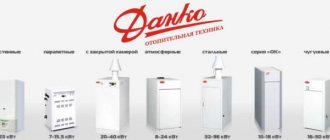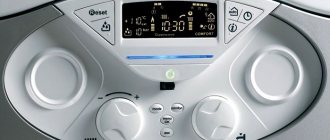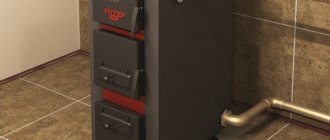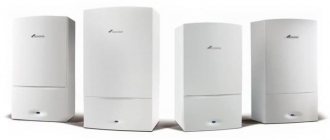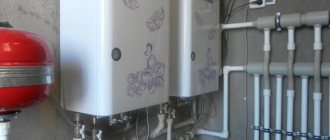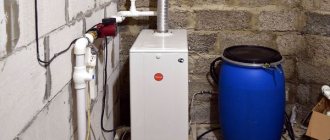Home / Gas boilers
Back
Published: 03/04/2020
Reading time: 7 min
0
4258
The Danko brand is known in the CIS countries for its gas boilers. The first Danko boiler was produced in the Ukrainian city of Rivne in 2002.
Today the company sells heating products on markets in Russia, Belarus and Moldova, significantly expanding the brand line.
- 1 About the manufacturer 1.1 Official website where you can see all models and factory instructions
- 6.1 The wick goes out
How to turn on a gas boiler?
How to light a boiler
- Open the gas tap.
- Place the gas block handle in the “Ignition” position.
- Press the “Start” button, hold it for about 10 seconds, then press the piezo ignition button 2-3 times until it clicks (ignition is possible through the viewing window using a burning match).
3 Jun
2022 Interesting materials:
What's in nuts? What's in tobacco? What saved Grinev? What helps reduce greenhouse gas emissions? What caused Grinev's duel? What caused the poet's first exile to the Caucasus? What happened to the phoenix after Dumbledore's death? What happened to Bayan Yesentaeva’s face? What happened to Hector's wife? Which is older, Yiddish or Hebrew?
About the manufacturer
The owner of the Danko brand is Ukrainian, which simultaneously produces heating equipment with several items. Danko boilers are manufactured using imported equipment from Japan, Finland and Denmark. This has significantly improved the performance quality of manufactured products, making them more reliable and durable.
In the production process of boiler equipment, modern assembly and metalworking machines and a powder coating line are used.
The vast majority of technological operations are automated. All boiler units have high efficiency - over 88%. The assortment set includes modifications with a cast iron heat exchanger, the service life of which is more than 25 years.
The advantages of such units include the availability of spare parts on the market, low cost of the kit and reliability.
Many units have been operating for more than 15 years in practice. The high efficiency of models up to 20 kW is determined by low fuel consumption: from 0.8-1.7 m3 of gas per hour.
However, the unit also has disadvantages. Buyers complain about the low level of assembly. Cheap kits are not equipped with modern automatic systems.
The assemblers note the relatively complex processes of assembly and piping with the in-house heating system, as well as increased background noise when the boiler is on, compared to Western analogues. According to responses on the Internet, Danko’s double-circuit options, with a high level of hot water supply, do not always provide the required heating rate.
Official website where you can view all models and factory instructions
The organization TD Finist LLC in Taganrog is the official representative of the company; boiler models can be found on Danko.rf. The following heating boilers are sold in Russia: “Danko”, “Danko-Breeze”, “OK”, which are certified according to Russian standards.
In Ukraine, the official website of the company: danko.ua. On the Internet you can find out about new modifications of boilers, their characteristics and customer reviews.
You can download factory instructions and boiler wiring diagrams, and get consultations with leading company managers.
The most reliable models with prices and technical characteristics
The product range contains more than 300 options for heating boilers with heating output from 2 to 1000 kW, which are installed for autonomous heating:
- natural/liquefied gas, solid fuel and pellets, electricity;
- open and closed;
- single-circuit and double-circuit;
- with natural and forced circulation;
- floor boiler;
- heat exchanger metal: steel, cast iron and copper.
- micro-flare burners made of heat-resistant non-corrosive steel.
All units are equipped with automatic safety systems:
- HONEYWELL - Netherlands;
- SIT - Italy;
- KARE - Poland.
The best solid fuel boilers for 150 m2:
- DANKO-12 VSR, power 12 kW, efficiency 91.5%, open combustion chamber, steel heat exchanger, mechanical control, centrifugal pump, price - 21,219 rubles.
- DANKO-20VSR, power 20 kW, efficiency 92%, open combustion chamber, steel heat exchanger, mechanical control, centrifugal pump, price - 32,685 rubles.
- OK-18V, power 18 kW, efficiency 90.5%, open combustion chamber, steel heat exchanger, centrifugal pump, electronic control, price - 27,172 rubles.
Popular Danko boilers operating on gas fuel for heating areas from 150 to 500 m2:
- DANKO-16LS, power 16 kW, efficiency 90.0%, open combustion chamber, cast iron heat exchanger, centrifugal pump, mechanical control, price - 38,001 rubles.
- DANKO-25LS, power 25 kW, efficiency 90.0%, open combustion chamber, cast iron heat exchanger, centrifugal pump, mechanical control, price - 47,531 rubles.
- DANKO-33LS, power 33 kW, efficiency 90.0%, open combustion chamber, cast iron heat exchanger, centrifugal pump, mechanical control, price - 60,238 rubles.
- DANKO-41LS, power 33 kW, efficiency 90.0%, open combustion chamber, cast iron heat exchanger, centrifugal pump, mechanical control, price - 68,814 rubles.
- DANKO-50LS, power 50 kW, efficiency 90.0%, open combustion chamber, cast iron heat exchanger, centrifugal pump, mechanical control, price - 85,492 rubles.
Characteristics of Danko pellet boilers for a heated area from 150 to 1500 m2:
- DANKO-150 TEM, power 150 kW, efficiency 88.0%, fuel supply, steel heat exchanger, centrifugal pump, mechanical control, price - 330,400 rubles.
- DANKO-100 TEM, power 150 kW, efficiency 88.0%, fuel supply, steel heat exchanger, centrifugal pump, mechanical control, price - 296,200 rubles.
- DANKO-75 TEM, power 150 kW, efficiency 89.0%, fuel supply, steel heat exchanger, centrifugal pump, mechanical control, price - 330,400 rubles.
- DANKO-50 TEM, power 150 kW, efficiency 88.0%, fuel supply, steel heat exchanger, centrifugal pump, mechanical control, price - 267,100 rubles.
- DANKO-25 TEM, power 150 kW, efficiency 89.0%, fuel supply, steel heat exchanger, centrifugal pump, mechanical control, price - 182,300 rubles.
- DANKO-17 TEM, power 150 kW, efficiency 88.0%, fuel supply, steel heat exchanger, centrifugal pump, mechanical control, price - 152,200 rubles.
Operation and Maintenance
After starting the boiler unit, before the heating system warms up, condensation collects on the walls of the combustion chamber, which begins to flow into the firebox and the main burner on the hearth.
In this case, the coolant temperature should be increased to 70C in this mode; the condensation process will stop. It is also not allowed to take water for hot water supply from the heating system.
During operation of the boiler, the temperature of the coolant and its pressure are monitored. It is necessary to periodically check the vacuum in the boiler and the combustion quality of the nozzle.
In case of spontaneous shutdown of the unit, first of all, check the draft in the chimney system. A hot draft sensor indicates that there is reverse draft in the system.
For long-term trouble-free operation of the boiler unit, before supplying the mains power to the device, place a water purification filter, and from time to time the heating circuit is flushed with clean tap water.
Recommendations
Despite the fact that Danko boilers have a long service life and reliability, some breakdowns still occur.
Therefore, all owners of gas equipment should know the main types of malfunctions and the causes of their occurrence.
- The formation of soot and soot on the internal surfaces of the boiler indicates problems with the chimney. In this case, you should clean the pipe from accumulated combustion products and wash the parts of the device from dirt.
- Unstable operation of the device and temperature fluctuations in the system indicate a malfunction of the fan or circulation pump. If you have the necessary spare parts, you can repair the device yourself.
- If the boiler's pilot light goes out or the wick does not light, the reason is most likely the absence of a special valve in the chimney system that prevents backdraft. The igniter going out may also be due to the thermostat tripping. In this case, adjustment of the device is necessary, which should be done by experienced specialists. Only single-circuit boilers are subject to attenuation. In dual-circuit devices, such problems are not observed.
- If the combustion sensor or pipe fails, the device is urgently disconnected from the gas supply and left to cool. Repairs can only be performed when the breakdown is not related to a fuel leak. For example, cleaning the pipe can be done independently, but more serious faults should only be trusted to a specialist.
- Increased fuel consumption and the presence of extraneous noise before attenuation are most likely caused by a failure of the controller. If you have the necessary spare parts, you can repair the part yourself.
In the next video you will find a review of the Danko 12.5 TN solid fuel boiler.
Autonomous heating systems for private houses are gradually becoming no less common than centralized networks.
This is caused by the desire to save on paying for network resources, the unavailability of connecting to a central heating center in remote cottage villages, or other reasons.
There are a large number of samples of heating devices on the market, of which gas boilers are unanimously recognized as the most effective.
They are produced by all well-known companies in Europe and Southeast Asia.
Manufacturers from the countries of the former USSR are not lagging behind, their products are able to successfully compete with European models.
Basic problems
Potential breakdowns in the boiler unit and methods for eliminating them are described in the instructions for use included in the delivery kit. List of probable defects. Why the boiler may not turn off and methods of correction are included in a special table.
The wick goes out
For boilers equipped with “SIT” automation, when, when the boiler is fired up, the pilot burner device goes out, and turning it on again does not produce results, then one of the likely causes of the failure is poor contact between the power terminals and the primary draft sensor.
To eliminate the failure, you need to disconnect the connection from the sensor, carefully tighten the terminal, having previously cleaned the contacts, connect the wire and turn on the burner again.
Reasons why the burner may go out:
- Gas output to the boiler unit is blocked.
- Low gas pressure in the network.
- Airiness of the pipe section in front of the boiler.
To purge the gas pipeline, you need to press the button on the gas shut-off valve and hold it for 60 seconds, after which the device is started again.
Igniter does not light
If the pilot burner goes out after the user releases the start button or the igniter does not light, you need to check the operation of the thermocouple, which may be located outside the combustion zone or there is a leak in the thermocouple junction at the inlet to the thermocouple.
In this case, you will need to adjust the location of the thermocouple in relation to the pilot burner flame; it must wash at least 4 mm of the thermocouple sensor.
It is recommended that before starting the boiler, blow out the ignition pipeline, injector and adjust the air supply with the nut to the KARE ignition mixer.
To do this, clean the connection point between the thermocouple and the thermoelement, tighten the nut until it stops by hand and tighten it 1/4 turn with a gas wrench.
Owner reviews
To obtain more balanced information, it is useful to consider the opinions of the other side - users and owners of Danko boilers.
They have no material or reputational interest in concealing or distorting facts, therefore all information received from them is doubly valuable:
- I have been using a Danko boiler for about a year now. It worked fine through the winter, no failures or problems arose. Gas is consumed quite economically, operating the boiler is very simple, everything is clear and without instructions. My boiler has a floor-standing design, but does not take up extra space. A good unit for a very reasonable price, I recommend it to everyone.
- I have a Danko floor-standing double-circuit boiler with an atmospheric combustion chamber. He worked for me for two years. In general, it copes with its task, the house is warm and there is hot water. But there are also some complaints - the gas consumption is too high and the burner often goes out. I think that my boiler justifies its cost, but it could have been done better.
- When the old boiler became unusable, I chose the new Danko-18. It has already worked all winter, and I can definitely say that gas consumption has decreased by about a third compared to the old boiler. It works quite steadily, even though it has an open burner. I had the same old one, I got used to handling them - the main thing is not to create drafts, and my chimney was installed correctly, the wind does not blow. The controls are simple, the operating mode is maintained smoothly.
- For heating and supplying hot water, we bought a Danko wall-mounted double-circuit boiler. The house is small, it was possible to get a cheaper boiler, but the seller recommended this one. When they installed it and started using it, it seemed like they had overpaid. However, after a couple of months we realized that the boiler was normal and fully operational. It doesn't consume much gas and is quite economical.
- I myself am involved in the construction and improvement of houses. For heating I always recommend that people buy Danko boilers. I have one like this in my house. It is economical, reliable, does not consume excess fuel, is easy to operate, and is compact. It performs all its functions as expected, and there is nothing superfluous in it.
- A good, reliable and inexpensive boiler. My friends have had Danko for several years now, I’ve seen enough of them and bought the same one myself. It works silently, the controls are simple and intuitive, without instructions. In terms of gas consumption, I have nothing to compare with, but my neighbors seem to be doing better than me. In general, I am satisfied and recommend it to everyone.
- I didn't know which boiler to choose. Imported ones are very expensive, so I bought a Ukrainian Danko boiler. It has already worked for me for 1.5 seasons. It consumes quite a bit of gas, so far there have been no problems in operation. Sometimes the burner goes out on its own, but this is infrequent; the master said that drafts or gusts of wind outside are to blame.
Here you will learn:
Heating equipment from the Danko brand is in definite demand among domestic consumers. Its key feature is simplicity, which ensures a long service life and reliability of the manufactured equipment. The Danko boiler will be an excellent choice for heating premises for any purpose - most often they are residential buildings. In this review, we will look at the most interesting models and introduce you to user reviews.
Types
The Danko range of gas boilers includes 22 modifications, differing in design and functionality. The units are available in single- and double-circuit versions. Single-circuit AOGV models are designed for heating and do not have the function of heating water for a hot water supply system. More powerful dual-circuit appliances provide the consumer not only with heating, but also with hot water. In such devices there are two circuits independent from each other, in each of which the desired temperature is set.
Danko boilers are equipped with two types of combustion chambers: open and closed. In the first, the air required to maintain combustion is taken from the room in which the boiler is installed. While in closed-type chambers the flow of oxygen is carried out through a coaxial chimney pipe, through which exhaust gases are removed. Closed cells are safer. They do not burn oxygen in the home and make the gas combustion process completely isolated from the room.
Based on the installation method, models are classified into three types.
- Mounted options are considered the lowest power, the power of which can be 8, 10, 12 and 15 kW. The devices are equipped with both copper and steel heat exchangers, have single- and double-circuit designs and are capable of heating a room of up to 210 square meters. The advantage of wall-mounted units is their light weight, small dimensions, electric ignition system and protection against freezing of the coolant. In addition, some models are equipped with a self-diagnosis function, which allows you to quickly and accurately determine the malfunction and repair the breakdown. The average consumption of wall-mounted units is 2.5 cubic meters of gas per hour, and the membrane tank can hold up to 6 liters.
- Floor-standing units with an open-type combustion chamber are distinguished by greater power, which for serious boilers reaches from 20 to 24 kW. The models are equipped with pumps that support forced circulation of the coolant, a steel or cast iron heat exchanger, and a control system that allows you to regulate draft and flame levels, as well as the moment of water boiling. All floor-standing units are equipped with a gas shut-off system in case of insufficient draft or flame extinction, have a wide range of models and are capable of heating a room of up to 360 square meters. The most powerful models with a cast iron heat exchanger are capable of developing power up to 50 kW.
Device (automation)
The main element is the gas burner. It heats the heat exchanger in which the coolant is located.
It is supplied by gravity or under the action of a circulation pump (purchased separately and connected as an external component of the system) into the heating circuit.
For double-circuit models, a coil is installed around the smoke pipe to heat the hot water of the DHW circuit.
Smoke is exhausted naturally, using the chimney draft, to which the boiler should be connected during installation.
The installation of the heating system must be carried out taking into account the placement levels of radiators that ensure natural circulation of the coolant.
If this is not possible, you have to use a circulation pump, which stabilizes the liquid movement mode, but makes the boiler energy-dependent.
Installation
The thermal power of the unit must be selected according to the design for heating the house in order to ensure a sanitary thermal regime in the premises.
The lowest ambient temperature during operation is not lower than 5 C. When installing the boiler, the circulation speed of the centrifugal pump and the total volume of coolant in the network must be taken into account.
Basic provisions when installing a Danko boiler:
- Before installing the unit, a heat-resistant horizontal foundation is made. The walls are shielded with heat-resistant materials, the gap between the wall and the boiler is left at least 250 mm. The insulating layer should extend beyond the dimensions of the housing by 150 mm.
- In front of the front working wall of the device, free passage is at least 100 cm.
- It is forbidden to wall up the base of the unit into the floor, since the process of air intake into the combustion chamber will be disrupted.
- The boiler unit is placed below the level of the batteries for efficient coolant circulation within the heating circuit.
- The expansion tank is installed at the highest point of the heating network, mainly in a heated place.
- The unit is installed with a chimney more than 5 m from the level of the chimney, which is located in the boiler.
- The height of the pipe above the roof is set above the level of wind pressure, and not less than 50 cm above the roof ridge.
- The main smoke exhaust duct must be located vertically, have smooth internal surfaces, without turns or kinks.
- The design of the chimney must ensure that the temperature of the flue gases at the outlet of the boiler unit is greater than the dew point temperature.
- The connection between the gas pipe of the unit and the chimney is made with a zinc or non-corrosive pipe.
- The unit must be installed and maintained exclusively in rooms with stable supply and exhaust ventilation
- The boiler is connected to the system using easily removable connections: couplings, union nuts or flanges and cannot be accompanied by high pipe tension.
- Sections of heating pipes operating with natural circulation are made with a slope of 10 mm per 1 m in the direction of the battery to collect air and remove it when the system is filled with water.
- The connection of gas appliances to the boiler is carried out by representatives of Gorgaz.
Circulation pump
Air often accumulates in it, and its blades sometimes seem to get stuck (the boiler will display a corresponding error).
It is recommended to rotate the shaft manually before starting.
To do this, you need to remove the front panel of the housing, unscrew the central bolt on the pump and use a straight-bladed screwdriver to turn the shaft in the direction indicated by the arrow.
An air vent is installed above the pump. You need to pull the bright lid up and let the air escape.
Floor-standing boilers are usually more powerful than wall-mounted ones. If you need to heat a large room, it is better to choose this option. Floor-mounted gas boilers for home heating – overview of design options and models.
Read about the installation features of combined heating boilers in the following material.
Conclusion
At first, the system may make gurgling sounds, all because during startup it is impossible to bleed air down to the last atom. It will gradually be removed through the expansion tank valve. Periodically check the pressure on the pressure gauge - it should be within the operating range. Temperature adjustment and other boiler settings are described in the instructions for each model.
Peculiarities
Danko heating boilers are rapidly gaining popularity in European countries. The demand is explained by its affordable cost, high level of efficiency and aesthetic appearance.
In addition, many models are compact in size, which is important when installing boiler equipment in small rooms. The boiler can easily fit into small kitchens and bathrooms, where, thanks to its miniature dimensions, it will harmoniously fit into the interior and will not clutter up the space
High consumer demand for Danko gas equipment is due to such undeniable advantages of Ukrainian appliances as:
- full compatibility with domestic communications and Russian gas, as well as good adaptability to harsh climatic conditions, distinguishes boilers of this brand from models from other manufacturers; the boilers fit perfectly with old cast iron batteries and do not require replacement of piping systems and radiators;
- the comfortable cost of the products allows you to solve the problem of heating and hot water supply for little money; You can purchase the device for 10–15 thousand rubles.
- the presence of an automatic protection system guarantees complete safety and comfortable use of gas equipment;
- long service life, reaching 25 years, is due to the use of the latest technologies with the use of high-quality components, which distinguishes cast iron boilers from other models that can last only 15 years; in addition, the manufacturer provides a three-year warranty on all gas equipment;
- high heat transfer of devices is achieved thanks to steel heat exchangers, and rapid heating of the coolant is ensured by a copper coil, which can significantly reduce the time of heating water and significantly increases the efficiency of the device;
- the silent operation of the devices allows you to install boilers in residential premises without fear of the presence of extraneous sounds in the house;
- the possibility of using boilers in systems without forced water circulation is due to the complete energy independence of the device, which is quite convenient during frequent power outages and voltage surges;
- The presence of detailed operating instructions that describe in detail the process of connecting to the system allows you to install the boiler yourself, without using expensive tools or calling a specialist.
The disadvantages of Danko heating units include the design features of the horizontal chimney in wall-mounted models. The fact is that with sharp gusts of wind, the flame in the burner may go out. In addition, wall-mounted appliances have less power and require constant cleaning of the chimney.
